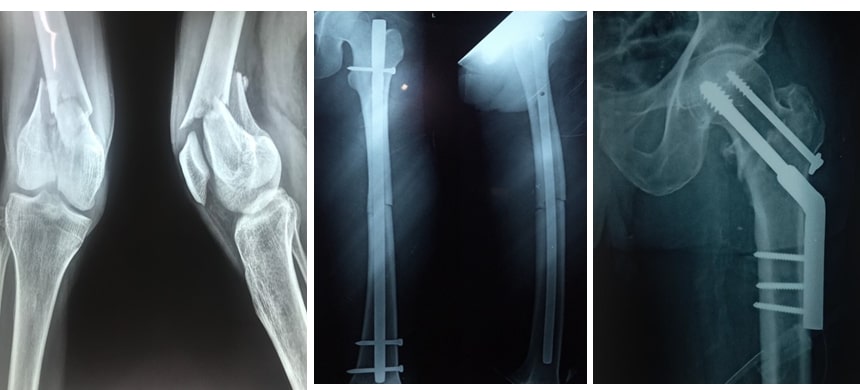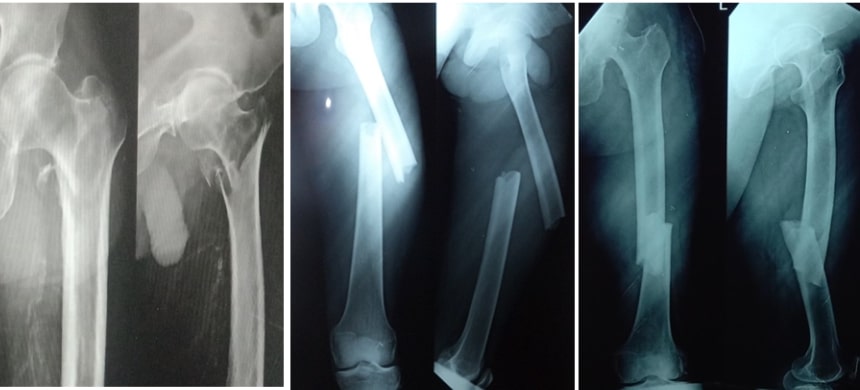Fracture care
We have got 206 bones in our body. Each bone is strong and compact but they can withstand only a particular amount of weight and force. If the weight and force exceed the capacity of that particular bone, then the bone will bend and get fractured. If the fracture fragments are very near to each other they unite very easily. This kind of fractures can be treated without surgery by the use of plaster of Paris. Like that the hairline fractures can be immobilised for a few weeks so that the fracture will unite on its own.
But if the fragments are displaced from each other then there is a lot of chance of non-union of the fracture. So this fracture should be fixed in the correct anatomical position. This kind of fixation needs the use of plates, screws etc. If we fix the fragments in good anatomical position and if the bone fragments get very good blood supply then the fracture will unite very well.
If a displaced fracture comes out of the skin or the fracture fragment is piercing the skin and coming out of the internal environment it is called an open fracture. This kind of open fracture has got a high risk of getting an infection because it is exposed to the external environment which contains dust, soil and bacteria. So, this contaminated fracture has got a lot of chances for going for non-union that means not getting united. So, this kind of open fractures need debridement for cleaning of the wound as well as cleaning of the fracture site and fixation of the fracture using modern implants or fixators. These open fractures need very good care so that in these kinds of situations we do keyhole surgeries also.
Making a small hole and fixing the fractures through the small hole by using plate, screws or nails is called minimally invasive surgery or keyhole surgery. As we are not opening the fracture site, we are not damaging any muscles, nerves or blood vessels around the fracture. We keep the internal environment of the fracture intact. So, the healing of the fracture will be quick and there is no loss of blood in this kind of Keyhole surgeries. The invention of C arm machines and the latest surgical equipment's made keyhole surgeries possible in orthopaedic field.
Most of the fractures of the leg bones are operated and fixed using this keyhole surgery. Most of the fractures of arm and forearm are fixed with plate and screws. Intra-articular fractures are the fractures involving the articular surface of bones. They need to be reconstructed properly. They should be fixed with proper implants. This fixation is very important to get back the moments of any joint.
Fixing fractures using metal plates and screws has been in practice for more than 50 years. Most of the times stainless steel has been used to make this kind of plate and screws. Nowadays titanium is being used as a preferred metal for the preparation of plates, screws, nails , locking nails and elastic nails. Both these implants are very good. But titanium has got some advantages over stainless steel. Titanium is not getting rusted and is more bio compatible. Titanium will not interfere with the CT scans. But it is costly comparing with stainless steel.
These implants are fixed with the bone or strong. They don’t get dissolved by themselves. Once these fractures healed very well then there is no need for retaining those implants inside the body. They can be removed. After a few years of fracture fixation once these bones get back their strengths then we can remove them. There are some biodegradable screws and plates which will disintegrate inside our body after a certain period of times. These biodegradable implants are not very strong. And many times, they create a certain kind of allergic reaction inside our body. Many of these implants are still in the experimental stage. They are very costly too. In the future, we can expect some cheap, strong and biologically inert biodegradable implants in the market.
To follow/subscribe our Social Media pages




